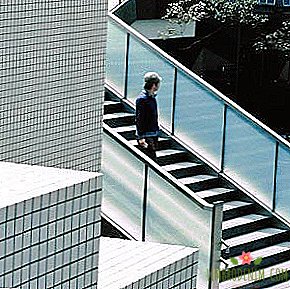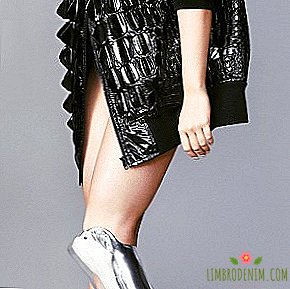I build robots that will build cities: Robotics about the world of the future
Last week, the development of the Russian robotics Maria Yablonina hit the top ten futuristic projects in 2016 according to Dezeen - one of the most popular publications on design. A graduate of the Moscow Institute of Architecture and the ITECH master program in Stuttgart has created mini-robots for her master's project that can weave light hanging structures made of threads. Now Maria continues her studies: after graduating from university she got into the art residence of Autodesk Pier 9, and then began work on her PhD thesis at the Institute for Computational Design (ICD) in Stuttgart. In the future, the technology Maria is working on can be used to create large engineering structures, such as bridges.
Construction robots are a new technology that only a few universities around the world use, including ITECH in Germany, IAAC in Spain, ETH in Switzerland, and SCI-Arc in the USA. In the future, robots will speed up the construction process and help build houses even in the most difficult conditions. For example, some architects suggest using machines to build houses on Mars. On the eve of her lecture in Moscow, Maria told us about recent projects, work in the traditionally "male" field and the future of automation.
 I know you used to do sculpture.
I know you used to do sculpture.
After the second course of MARCHI, I got a job at Media Art Lab, an organization that at that time was involved in the art program of the Moscow Film Festival. I still do not understand why they took me: I was twenty years old and I did not understand anything in art, but I was invited to work as an exhibition architect. I made an exhibition for MMOMA in Ermolaevsky lane, and since then we have collaborated with them.
Over time, I had a connection, the projects themselves began to fall into my hands. I met many artists and once came across a competition for young sculptors, which was organized by the gallery "Start" at Winzavod. It was necessary to come up with a sculpture of metal, and I decided to apply. I did not count on anything, but my project “One to One” won, and the sculpture was made at a huge shipbuilding factory in Moscow. Using the landscape measurement tools, I recognized the size of an important geographical point for me and reproduced it using metal sheets, using the classical architectural method of a layer-by-layer topographic image, but I chose a scale of 1: 1.
 What was this place?
What was this place?
I don't tell anyone about this. The meaning of the project was that I reported that this was a geographic point of some importance to me, but which one I did not say. It was interesting for me to reveal a little, but not to write a diary, but rather to present a newly reproduced landscape surface to get a new experience - you could walk around the sculpture.
It was the first experience of creating such a large object. I went to the factory, and the workers looked at me with strange eyes — a 20-year-old girl told them what to do. After that, I made the installation “The Vanishing Wall” together with the German architect Werner Sobek in Gorky Park. It was a competition of the Goethe Institute, which was held among my group at the Moscow Institute of Architecture and Architecture: a project had to be made that showed the interrelationship of the cultures of Russia and Germany. We made a large wooden frame, inside which was a transparent design. Small wooden cubes were inserted into it, each of which contained a quote from a famous German author with translation into Russian. Viewers could pick up these cubes as souvenirs. Gradually, the wall, which at the opening seemed monolithic, began to fade and became transparent by the end of the exhibition. And then my art career ended as quickly as it began.
 Why did you decide to build a robot that weaves a web?
Why did you decide to build a robot that weaves a web?
I already had experience with carbon fiber, fiberglass and filament materials in general. In addition, I did a little research on how to weave the web. After him, I realized that I would be interested in doing mobile robots. I wanted to understand how small robots can create large structures, because basically robots are more of those objects that they build. I thought that small mobile robots and fibrous materials are well combined, and together they allow you to create devices that can work on large spaces - you can "block" a huge room with one thread.
I began to explore the movement of mobile robots - robots with legs, wheels, quadcopters, and so on. I experimented with different configurations of threads and realized that it would be interesting for me to build a universal robot for the urban environment - I wanted it to attach to the facades of buildings and create another layer of architecture in an already existing environment, rather than build from scratch.
 And why the web?
And why the web?
While studying at the magistracy, we were asked to conduct research on a topic related to biology. I do not remember why spiders intrigued me so much. Probably because they are small creatures that build huge and geometrically complex structures. I concentrated on those kinds of spiders that weave a three-dimensional web, and not a standard spiral web; these are insects that have adapted to life in human conditions and which can be found in every basement. They create complex geometry around simple square shapes — in the corner or between the walls. In fact, this is a new architecture within an existing structure. Most modern buildings are rectangular, and I was interested in the combination of the complex geometry of the web and the very simple geometry of its formwork.
 Such a robot can do something big - for example, weave a bridge?
Such a robot can do something big - for example, weave a bridge?
At the present stage of research, this technology works only in the interior, there is no protection from the weather conditions. I would like robots to function both indoors (for example, creating furniture) and in an urban environment. One can imagine that several such robots can weave something for public spaces, such as awnings for a festival. So that immediately after the structure is no longer needed, the robots could unstuck it, assemble it into coils and transport it to another place. In this case, each time a structure is created at a new location, the geometry changes, depending on which walls are accessible and how the facades are constructed. At the same time, it is interesting for me to look very far into the future and to study how such solutions can be applied to the construction of bridges and other serious engineering structures.

 Does someone else do something like that?
Does someone else do something like that?
I became interested in mobile robots thanks to the Minibuilders project of Peter Novikov and his colleagues from the IAAC. Now many scientists and architects involved in robotics are fond of industrial robots and pay little attention to something else.
It seems to me that all modern research on industrial robots is very interesting, but in parallel other types of devices should be developed - for example, robots designed specifically for construction. I want to move in this direction and maybe connect such robots with other existing machines and use several different types of devices that work together in the same production.
There are researchers who deal with quadrocopters using threads. At the last demonstration, three or four active quadrocopters interact in space and build from ten thick ropes a simple bridge that sustains a person. In general, not as many institutions deal with mobile robots as I would like. This is a relatively new topic in architecture.
 In your project Autodesk you combine industrial and mobile robots. They have completely different tasks.
In your project Autodesk you combine industrial and mobile robots. They have completely different tasks.
It was interesting for me to build a system - from the point of view of both electronics and software - of two very different machines that can exist in the same space. One machine is an industrial robot, the other is more DIY. It was necessary to figure out how they learn about the location of each other. In the case of a mobile robot, it is necessary to predict where it is located, what sensors should be used, so that machines can interact, in terms of programming, how to organize a sequence of actions for each device, and so on.
To be honest, I still do not really understand how I will apply the system, and in this sense the project is very different from the previous one, because then I was clear from the very beginning the goal to which I am going. Here I set myself the task to build a system that is flexible enough to be used differently in my research. It was interesting to me to simulate a situation in which those things that one machine cannot do can theoretically do two or three. I think that I will look for the application of this system with more specific things. For example, you can imagine a situation in which an industrial robot performs those tasks that require high accuracy and high payload, while the mobile robot takes the material or moves it from place to place.
 How will robotization change our near future?
How will robotization change our near future?
I try to take a sober look at the current situation - for example, at Uber, who recently released the first autonomous taxi. I see a lot of problems in terms of legislation and economics that will be difficult to solve. For example, if tomorrow all people involved in transportation and transportation are replaced with autonomous cars, a huge cut of the unemployed population will appear, and all the wealth that has been distributed between a certain percentage of the workforce will be concentrated in the pocket of one company.
Now a lot of professions tied to logistics are being automated. Research in the field of artificial intelligence has progressed far in the last few years, and I know a huge number of areas in which, thanks to a new software, the number of people needed to complete tasks has decreased. It seems to me that this is a big problem, which is not given enough attention, and if it is not urgently addressed, then it is not clear how we will live.
 And what to do with it?
And what to do with it?
I support the idea of introducing basic income. If we imagine that a corporation is inventing software or electronics that automates a certain industry, then the profits that this company receives from new technologies should be partially distributed among the population. Otherwise, we come to a situation where even those small funds that workers now receive fall into the pocket of corporations, and this is very scary.
 And soon robots will begin to help in the construction of houses?
And soon robots will begin to help in the construction of houses?
In recent years there have been a lot of interesting projects: for example, the BIG bureau is building a new Google headquarters with the help of industrial robots. So far this is all very expensive, but, in my opinion, in ten to twenty years it will become a cheaper and more common technology. The difficulty lies in the fact that for each project you need to come up with special solutions - each building requires a certain system. Maybe in the future they can be assembled from modules that can be bought in a store like IKEA or rented. But so far there is a problem in financing. Smartphones were also very expensive technology, but as soon as mass production of necessary components became possible, everything became very cheap, and it seems to me that the same can happen with robots.
 So what will happen is the same as with the automotive industry?
So what will happen is the same as with the automotive industry?
I think that not yet, because in our sphere these processes are slower. I hope that by the time the automation touches the construction market, there will already be solutions that will help fight unemployment.
 How do you feel in an area that is still considered very "male"?
How do you feel in an area that is still considered very "male"?
I faced a lot of situations in which I was told: "Wait, do you do robots? You're a girl!" And these were my colleagues who worked in the same field. In everyday life, I also hear similar things from relatives and acquaintances. And this, of course, is a barrier that is difficult to overcome. Now I am very glad to start working on a PhD, because now I can influence others. Now I am in a position where they will listen to me more.
While working at Autodesk in San Francisco, the disparity was felt much less. But, of course, I understand that in San Francisco I was in such a bubble inside a bubble: I worked at Autodesk Pier 9, in which everything is generally good, and they support all minorities and believe in tolerance. In Germany’s academic environment, gender inequality is still a very sensitive issue. There are much more men at the academy, and this affects salaries and attitudes. Over the past few years there have been positive changes, but the ideal is still very far away.
 How can I fix this situation?
How can I fix this situation?
I want to believe that one of the reasons for misogyny is more about ignorance and ignorance than a conscious choice. It seems to me that we should be more active in talking about it. It would be great if there was a space in which I can, for example, complain about some gender problems. The main difficulty is that even many educated and high-ranking people lack knowledge in this area. They do not think about it, and for them it is not a problem. There is discourse, we are talking about this, but this is not enough.
 What would you like to do in the future: robots or something else?
What would you like to do in the future: robots or something else?
That's a very difficult question. While I am going to continue research, engage in mobile robots and interspecific interactions of robots. I hope that when I finish my PhD work, there will be new opportunities to stay in this environment - not necessarily in the academy, it would be great to work in the corporate laboratory.
I want to create a universal modular system that will help solve various problems. For example, when you need a quadrocopter, a mobile robot, and a robot hitch for building, you could work with them, and when your tasks change, you would use the same system, but combined the modules differently. While I am thinking about professional equipment, it would be interesting to see similar systems used for DIY projects.
Photo: Maria yablonina





